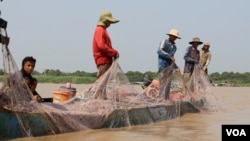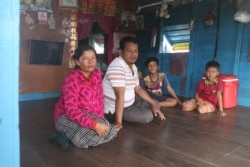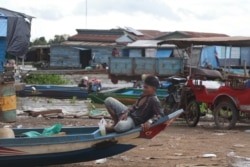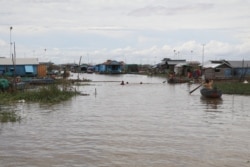Come August, Pursat province’s Kampong Luong commune is usually flooded from the swelling Tonle Sap Lake. The waters fill the village’s dusty paths, with all activity conducted around seven meters above ground level.
This year, there are villagers selling groceries and other items on the ground level, the small dirt paths in the village are still dry and dusty. There has been no flooding this year, with water levels in the lake at a record low, according to the Mekong River Commission.
The dropping water levels have hit Thoeun Veun’s daily fish catch, which has reduced from eight kilograms a day last year to just around 500 grams a day. The Kampong Luong-based fisherman said the water levels were lower than last year, especially since it has been three months since the onset of the monsoon.
“There is little fish this year. Next year, it will be worse,” he said.
“Now it is August already, but it still dried up and dusty,” added the father of four children.
Thoeun Veun said the main reason fish catch is low was that the water levels were insufficient for fish eggs to hatch or for the hatchling to grow or mature.
“The villagers along the river are hopeful for more water so the fish can hatch. If there is no water, how can fish hatch,” he added.
Veun’s family has had to resort to selling groceries and small items to supplement their livelihoods. For the last two years, Mich Kimsruon has sold day-to-day products to help her family.
“I am concerned that in the future, I will go to live on the land. But I don’t know what to do,” said the 35-year-old wife of Thoeun Veun.
“I am concerned that the next generation will not know Cambodian fish types since we don’t have fish now.”
In Chhnuk Tru commune, another floating village in neighboring Kampong Chhnang province that is reliant on fishing, villagers shared similar concerns over a lack of flooding in the area.
Sim Vantha, a local fisherman, is sitting on the edge of his boat ruing the reality that there was little or no fish to support his family.
“Yesterday I could catch fish only two kilograms, which is low. Before, I could fish like 8 kilograms,” said the 28-year-old fisherman and father of two.
“Last year this time, the water was here already, but now there is no water,” he added, pointing close to the boat.
Villagers along the Tonle Sap said they have no idea why the waters are receding every year, but that they have heard that hydropower dam construction along the Mekong River, which feeds the lake during the monsoons, was causing falling water levels.
The Mekong River Commission said in early August that Cambodia’s Tonle Sap Lake, which relies on reverse flows from the Mekong River during the wet season, has recorded the lowest flows since 1997. The lake is critical as a source of fish, both for sustenance and livelihood, for the millions of Cambodians dependent on the lake.
The commission asked countries along the waterbody to share data of falling water levels in the river, especially in light of the record dry conditions witnessed in the Tonle Sap lake area.
“We call on the six Mekong countries to increase data and information sharing on their dam and water infrastructure operations in a transparent and speedy manner with the MRC. It is time to walk the talk and to act in the common interest of the entire Mekong River Basin and the affected communities,” said Dr. An Pich Hatda, the MRC secretariat’s chief executive officer.
The Mekong River runs through China, Myanmar, Thailand, Laos, Cambodia, and Vietnam.
The Cambodian government in mid-July released data to show low water levels in the Mekong, largely attributing the drop to climate change.
As of August 20, Cambodian government data water levels at Kampong Luong, near the mouth of the Tonle Sap, were 1.74 meters, 10 centimeters higher than the previous day.
While the government didn’t provide historical data for water levels at Kampong Luong, further south along the Tonle Sap river, water levels at Prek Kdam in Kandal province were more than 3 meters lower than average levels for this time of year.
Other experts, especially the U.S.-based Stimson Center, contend that Chinese hydropower dams have not released water despite good precipitation in the upper Mekong River.
The U.S.-based Stimson Center, which tracks development along the river, published new data in April that suggests the lower Mekong Basin was facing a severe drought despite the upper basin had high rainfall and snowmelt, with China’s dams restricting nearly all of this record flow.
However, China’s Foreign Ministry has dismissed the findings, saying it was “unreasonable” that Chinese dam construction along the river was causing droughts downstream.
In a press conference on August 11, Chan Yutha, secretary of state at the Ministry of Water Resources and Meteorology, said Cambodia was facing the effects of El Nino.
“[No rain] is linked largely to the El Nino phenomena, which happened since 2019 and continued till early 2020,” he said.
The El Nino effect is caused by warmer-than-average temperatures in the Pacific region that causes changes in weather patterns, such as flooding or, more commonly, drought in the Mekong region.
Te Navuth, secretary-general of the Cambodia National Mekong Committee, said that the main reason for water shortages in the Mekong River and Tonle Sap Lake was the absence of no rain and drought caused by the El Nino effect.
He conceded that the dams along the Mekong River had a minor contribution minor to low water levels.
“The dams don’t block water forever, just for a [short] period of time,” he said.











